Target Information
| Target General Information | Top | |||||
|---|---|---|---|---|---|---|
| Target ID |
T44282
(Former ID: TTDR01185)
|
|||||
| Target Name |
Mitochondrial aldehyde dehydrogenase (ALDH2)
|
|||||
| Synonyms |
Aldehyde dehydrogenase, mitochondrial; ALDM; ALDHI; ALDH-E2; ALDH class 2
Click to Show/Hide
|
|||||
| Gene Name |
ALDH2
|
|||||
| Target Type |
Clinical trial target
|
[1] | ||||
| Disease | [+] 3 Target-related Diseases | + | ||||
| 1 | Cerebral ischaemia [ICD-11: 8B1Z] | |||||
| 2 | Cardiovascular disease [ICD-11: BA00-BE2Z] | |||||
| 3 | Unspecific substance use disorder [ICD-11: 6C4Z] | |||||
| Function |
Second enzyme of the major oxidative pathway of alcohol metabolism. Catalyzes the chemical transformation from acetaldehyde to acetic acid. Additionally, functions as a protector against oxidative stress.
Click to Show/Hide
|
|||||
| BioChemical Class |
Aldehyde/oxo donor oxidoreductase
|
|||||
| UniProt ID | ||||||
| EC Number |
EC 1.2.1.3
|
|||||
| Sequence |
MLRAAARFGPRLGRRLLSAAATQAVPAPNQQPEVFCNQIFINNEWHDAVSRKTFPTVNPS
TGEVICQVAEGDKEDVDKAVKAARAAFQLGSPWRRMDASHRGRLLNRLADLIERDRTYLA ALETLDNGKPYVISYLVDLDMVLKCLRYYAGWADKYHGKTIPIDGDFFSYTRHEPVGVCG QIIPWNFPLLMQAWKLGPALATGNVVVMKVAEQTPLTALYVANLIKEAGFPPGVVNIVPG FGPTAGAAIASHEDVDKVAFTGSTEIGRVIQVAAGSSNLKRVTLELGGKSPNIIMSDADM DWAVEQAHFALFFNQGQCCCAGSRTFVQEDIYDEFVERSVARAKSRVVGNPFDSKTEQGP QVDETQFKKILGYINTGKQEGAKLLCGGGIAADRGYFIQPTVFGDVQDGMTIAKEEIFGP VMQILKFKTIEEVVGRANNSTYGLAAAVFTKDLDKANYLSQALQAGTVWVNCYDVFGAQS PFGGYKMSGSGRELGEYGLQAYTEVKTVTVKVPQKNS Click to Show/Hide
|
|||||
| 3D Structure | Click to Show 3D Structure of This Target | PDB | ||||
| HIT2.0 ID | T32OC4 | |||||
| Drugs and Modes of Action | Top | |||||
|---|---|---|---|---|---|---|
| Clinical Trial Drug(s) | [+] 4 Clinical Trial Drugs | + | ||||
| 1 | ALD-401 | Drug Info | Phase 2 | Cerebrovascular ischaemia | [2] | |
| 2 | ANS-6637 | Drug Info | Phase 1 | Substance use disorder | [3] | |
| 3 | FP-045 | Drug Info | Phase 1 | Cardiovascular disease | [4] | |
| 4 | GS-6637 | Drug Info | Phase 1 | Substance use disorder | [5] | |
| Mode of Action | [+] 3 Modes of Action | + | ||||
| Modulator | [+] 1 Modulator drugs | + | ||||
| 1 | ALD-401 | Drug Info | [1] | |||
| Inhibitor | [+] 7 Inhibitor drugs | + | ||||
| 1 | ANS-6637 | Drug Info | [3] | |||
| 2 | GS-6637 | Drug Info | [6], [7] | |||
| 3 | Daidzin | Drug Info | [8] | |||
| 4 | crotylaldehyde | Drug Info | [8] | |||
| 5 | ISOFORMONENTIN | Drug Info | [9] | |||
| 6 | Nicotinamide-Adenine-Dinucleotide | Drug Info | [8] | |||
| 7 | prunetin | Drug Info | [9] | |||
| Agonist | [+] 1 Agonist drugs | + | ||||
| 1 | FP-045 | Drug Info | [4] | |||
| Cell-based Target Expression Variations | Top | |||||
|---|---|---|---|---|---|---|
| Cell-based Target Expression Variations | ||||||
| Drug Binding Sites of Target | Top | |||||
|---|---|---|---|---|---|---|
| Ligand Name: NADH | Ligand Info | |||||
| Structure Description | Human mitochondrial aldehyde dehydrogenase complexed with NADH in the presence of Mg2+ | PDB:1O02 | ||||
| Method | X-ray diffraction | Resolution | 1.90 Å | Mutation | No | [10] |
| PDB Sequence |
AVPAPNQQPE
16 VFCNQIFINN26 EWHDAVSRKT36 FPTVNPSTGE46 VICQVAEGDK56 EDVDKAVKAA 66 RAAFQLGSPW76 RRMDASHRGR86 LLNRLADLIE96 RDRTYLAALE106 TLDNGKPYVI 116 SYLVDLDMVL126 KCLRYYAGWA136 DKYHGKTIPI146 DGDFFSYTRH156 EPVGVCGQII 166 PWNFPLLMQA176 WKLGPALATG186 NVVVMKVAEQ196 TPLTALYVAN206 LIKEAGFPPG 216 VVNIVPGFGP226 TAGAAIASHE236 DVDKVAFTGS246 TEIGRVIQVA256 AGSSNLKRVT 266 LELGGKSPNI276 IMSDADMDWA286 VEQAHFALFF296 NQGQCCCAGS306 RTFVQEDIYD 316 EFVERSVARA326 KSRVVGNPFD336 SKTEQGPQVD346 ETQFKKILGY356 INTGKQEGAK 366 LLCGGGIAAD376 RGYFIQPTVF386 GDVQDGMTIA396 KEEIFGPVMQ406 ILKFKTIEEV 416 VGRANNSTYG426 LAAAVFTKDL436 DKANYLSQAL446 QAGTVWVNCY456 DVFGAQSPFG 466 GYKMSGSGRE476 LGEYGLQAYT486 EVKTVTVKVP496 QKNS
|
|||||
|
|
ILE165
3.464
ILE166
2.851
PRO167
3.353
TRP168
2.881
ASN169
3.091
LYS192
2.776
VAL193
4.230
ALA194
3.712
GLU195
2.815
GLN196
3.904
GLY223
4.560
PHE224
4.030
GLY225
3.278
PRO226
3.743
GLY229
3.225
ALA230
3.323
|
|||||
| Click to View More Binding Site Information of This Target and Ligand Pair | ||||||
| Ligand Name: Nitroglycerin | Ligand Info | |||||
| Structure Description | Crystal structure of human aldehyde dehydrogenase-2 in complex with nitroglycerin | PDB:4FR8 | ||||
| Method | X-ray diffraction | Resolution | 2.20 Å | Mutation | Yes | [11] |
| PDB Sequence |
VPAPNQQPEV
17 FCNQIFINNE27 WHDAVSRKTF37 PTVNPSTGEV47 ICQVAEGDKE57 DVDKAVKAAR 67 AAFQLGSPWR77 RMDASHRGRL87 LNRLADLIER97 DRTYLAALET107 LDNGKPYVIS 117 YLVDLDMVLK127 CLRYYAGWAD137 KYHGKTIPID147 GDFFSYTRHE157 PVGVCGQIIP 167 WNFPLLMQAW177 KLGPALATGN187 VVVMKVAEQT197 PLTALYVANL207 IKEAGFPPGV 217 VNIVPGFGPT227 AGAAIASHED237 VDKVAFTGST247 EIGRVIQVAA257 GSSNLKRVTL 267 QLGGKSPNII277 MSDADMDWAV287 EQAHFALFFN297 QGQSCSAGSR307 TFVQEDIYDE 317 FVERSVARAK327 SRVVGNPFDS337 KTEQGPQVDE347 TQFKKILGYI357 NTGKQEGAKL 367 LCGGGIAADR377 GYFIQPTVFG387 DVQDGMTIAK397 EEIFGPVMQI407 LKFKTIEEVV 417 GRANNSTYGL427 AAAVFTKDLD437 KANYLSQALQ447 AGTVWVNCYD457 VFGAQSPFGG 467 YKMSGSGREL477 GEYGLQAYTE487 VKTVTVKVPQ497 KNS
|
|||||
|
|
||||||
| Click to View More Binding Site Information of This Target with Different Ligands | ||||||
| Different Human System Profiles of Target | Top |
|---|---|
|
Human Similarity Proteins
of target is determined by comparing the sequence similarity of all human proteins with the target based on BLAST. The similarity proteins for a target are defined as the proteins with E-value < 0.005 and outside the protein families of the target.
A target that has fewer human similarity proteins outside its family is commonly regarded to possess a greater capacity to avoid undesired interactions and thus increase the possibility of finding successful drugs
(Brief Bioinform, 21: 649-662, 2020).
Human Tissue Distribution
of target is determined from a proteomics study that quantified more than 12,000 genes across 32 normal human tissues. Tissue Specificity (TS) score was used to define the enrichment of target across tissues.
The distribution of targets among different tissues or organs need to be taken into consideration when assessing the target druggability, as it is generally accepted that the wider the target distribution, the greater the concern over potential adverse effects
(Nat Rev Drug Discov, 20: 64-81, 2021).
Human Pathway Affiliation
of target is determined by the life-essential pathways provided on KEGG database. The target-affiliated pathways were defined based on the following two criteria (a) the pathways of the studied target should be life-essential for both healthy individuals and patients, and (b) the studied target should occupy an upstream position in the pathways and therefore had the ability to regulate biological function.
Targets involved in a fewer pathways have greater likelihood to be successfully developed, while those associated with more human pathways increase the chance of undesirable interferences with other human processes
(Pharmacol Rev, 58: 259-279, 2006).
Biological Network Descriptors
of target is determined based on a human protein-protein interactions (PPI) network consisting of 9,309 proteins and 52,713 PPIs, which were with a high confidence score of ≥ 0.95 collected from STRING database.
The network properties of targets based on protein-protein interactions (PPIs) have been widely adopted for the assessment of target’s druggability. Proteins with high node degree tend to have a high impact on network function through multiple interactions, while proteins with high betweenness centrality are regarded to be central for communication in interaction networks and regulate the flow of signaling information
(Front Pharmacol, 9, 1245, 2018;
Curr Opin Struct Biol. 44:134-142, 2017).
Human Similarity Proteins
Human Tissue Distribution
Human Pathway Affiliation
Biological Network Descriptors
|
|
|
There is no similarity protein (E value < 0.005) for this target
|
|
Note:
If a protein has TS (tissue specficity) scores at least in one tissue >= 2.5, this protein is called tissue-enriched (including tissue-enriched-but-not-specific and tissue-specific). In the plots, the vertical lines are at thresholds 2.5 and 4.
|
| KEGG Pathway | Pathway ID | Affiliated Target | Pathway Map |
|---|---|---|---|
| Glycolysis / Gluconeogenesis | hsa00010 | Affiliated Target |
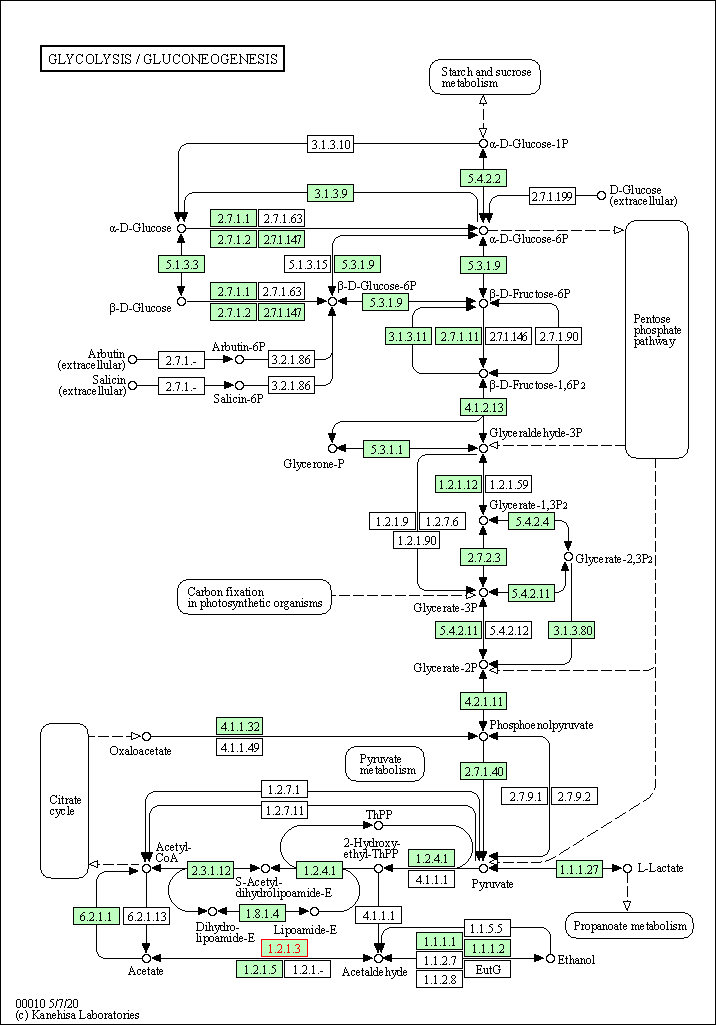
|
| Class: Metabolism => Carbohydrate metabolism | Pathway Hierarchy | ||
| Ascorbate and aldarate metabolism | hsa00053 | Affiliated Target |
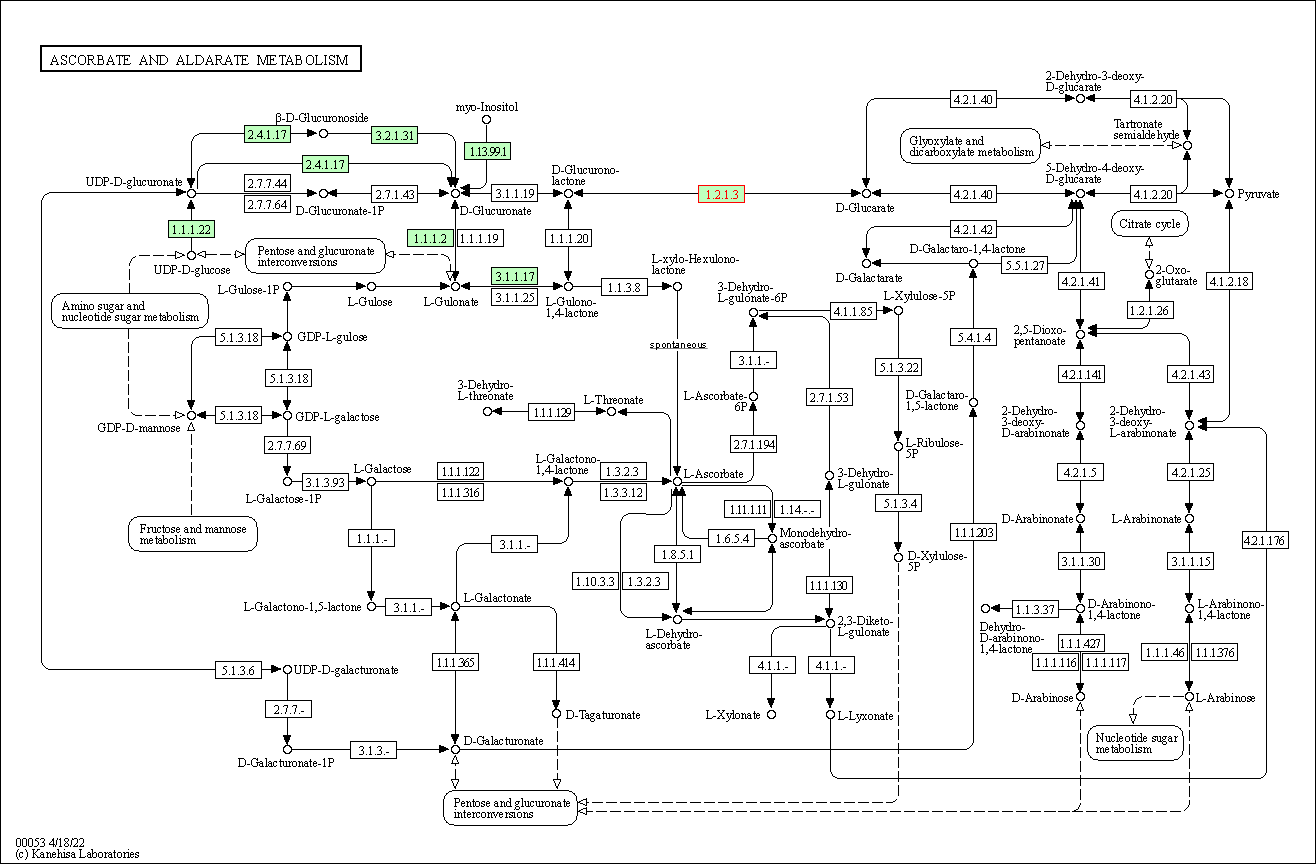
|
| Class: Metabolism => Carbohydrate metabolism | Pathway Hierarchy | ||
| Fatty acid degradation | hsa00071 | Affiliated Target |
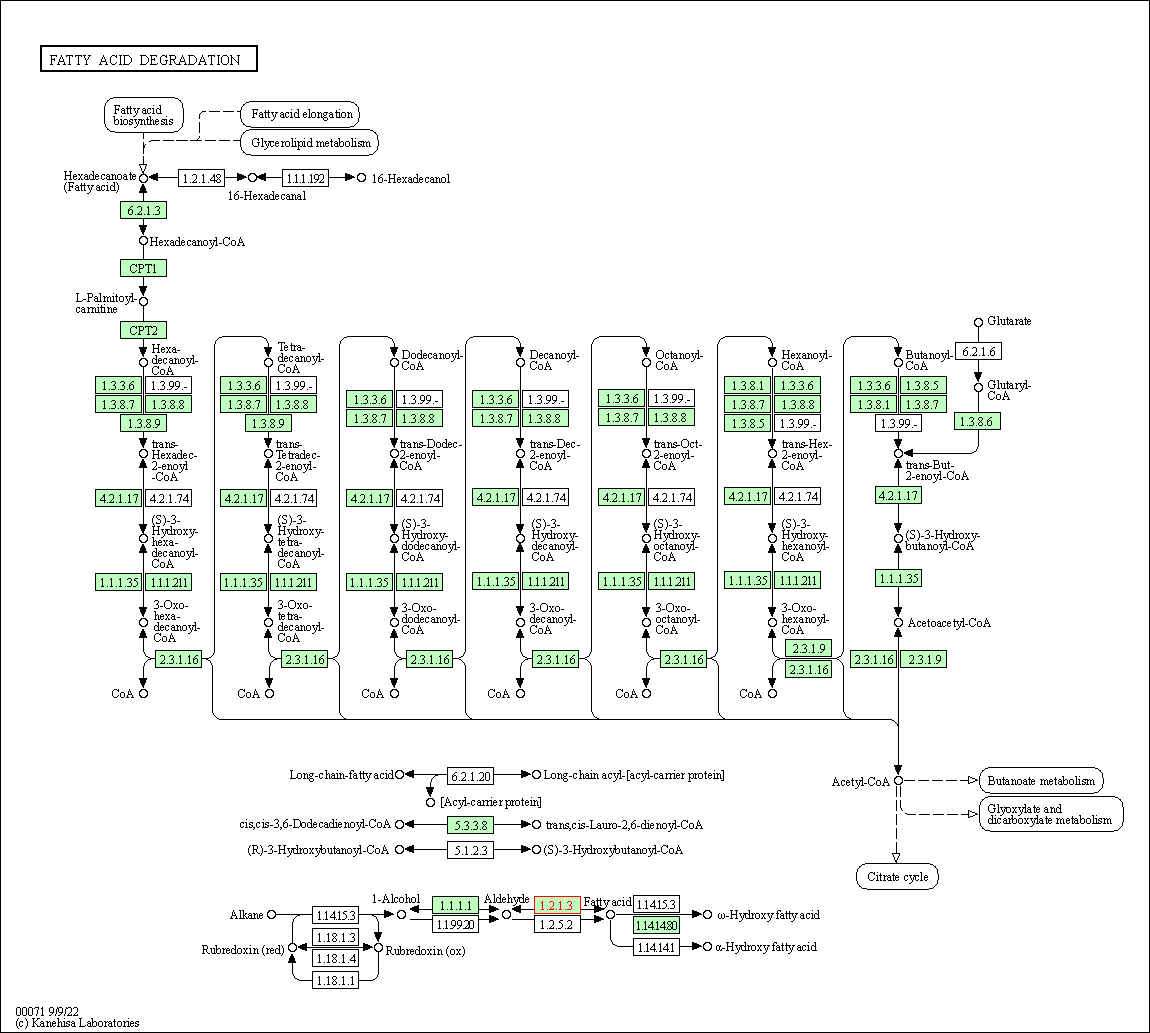
|
| Class: Metabolism => Lipid metabolism | Pathway Hierarchy | ||
| Valine, leucine and isoleucine degradation | hsa00280 | Affiliated Target |
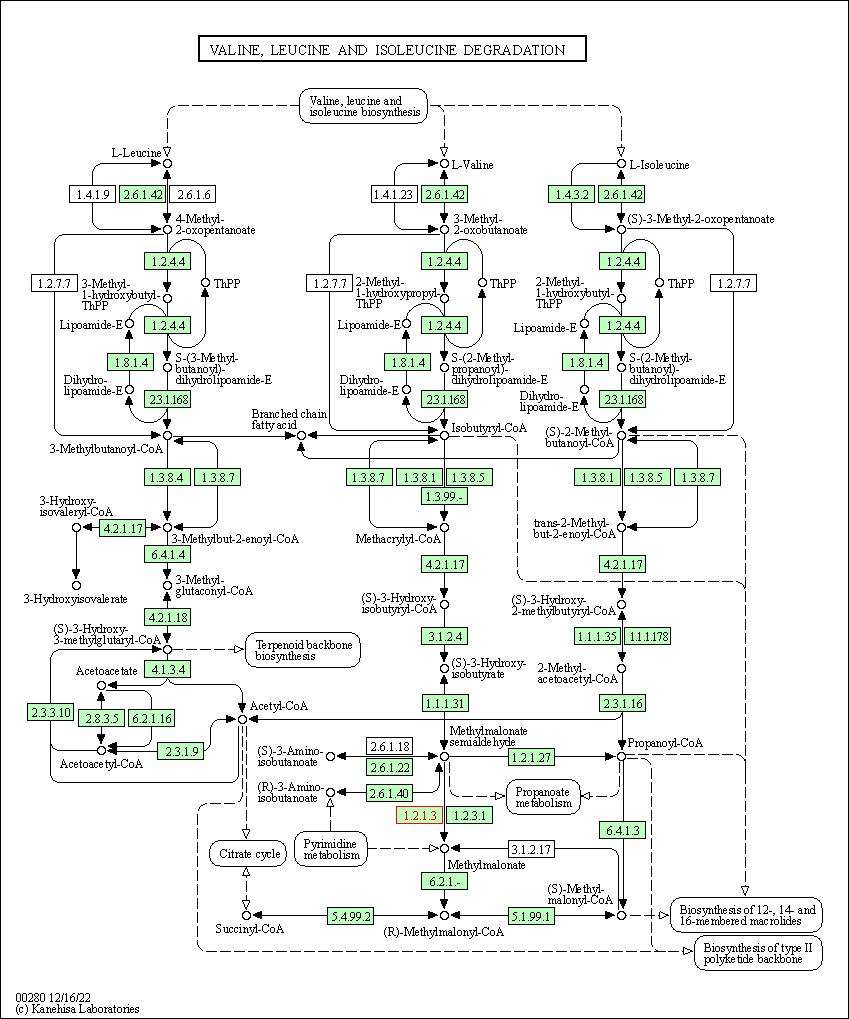
|
| Class: Metabolism => Amino acid metabolism | Pathway Hierarchy | ||
| Lysine degradation | hsa00310 | Affiliated Target |
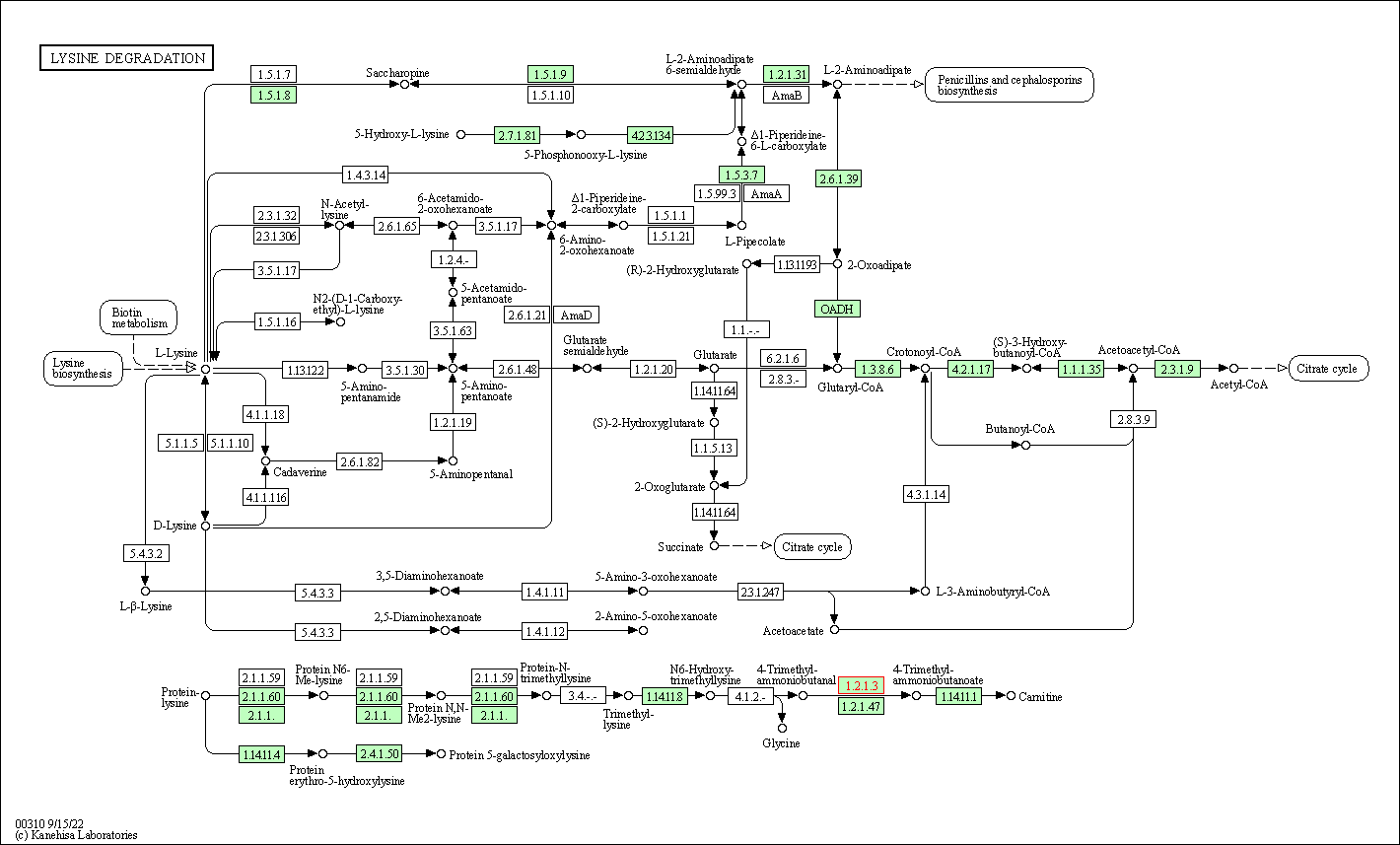
|
| Class: Metabolism => Amino acid metabolism | Pathway Hierarchy | ||
| Arginine and proline metabolism | hsa00330 | Affiliated Target |
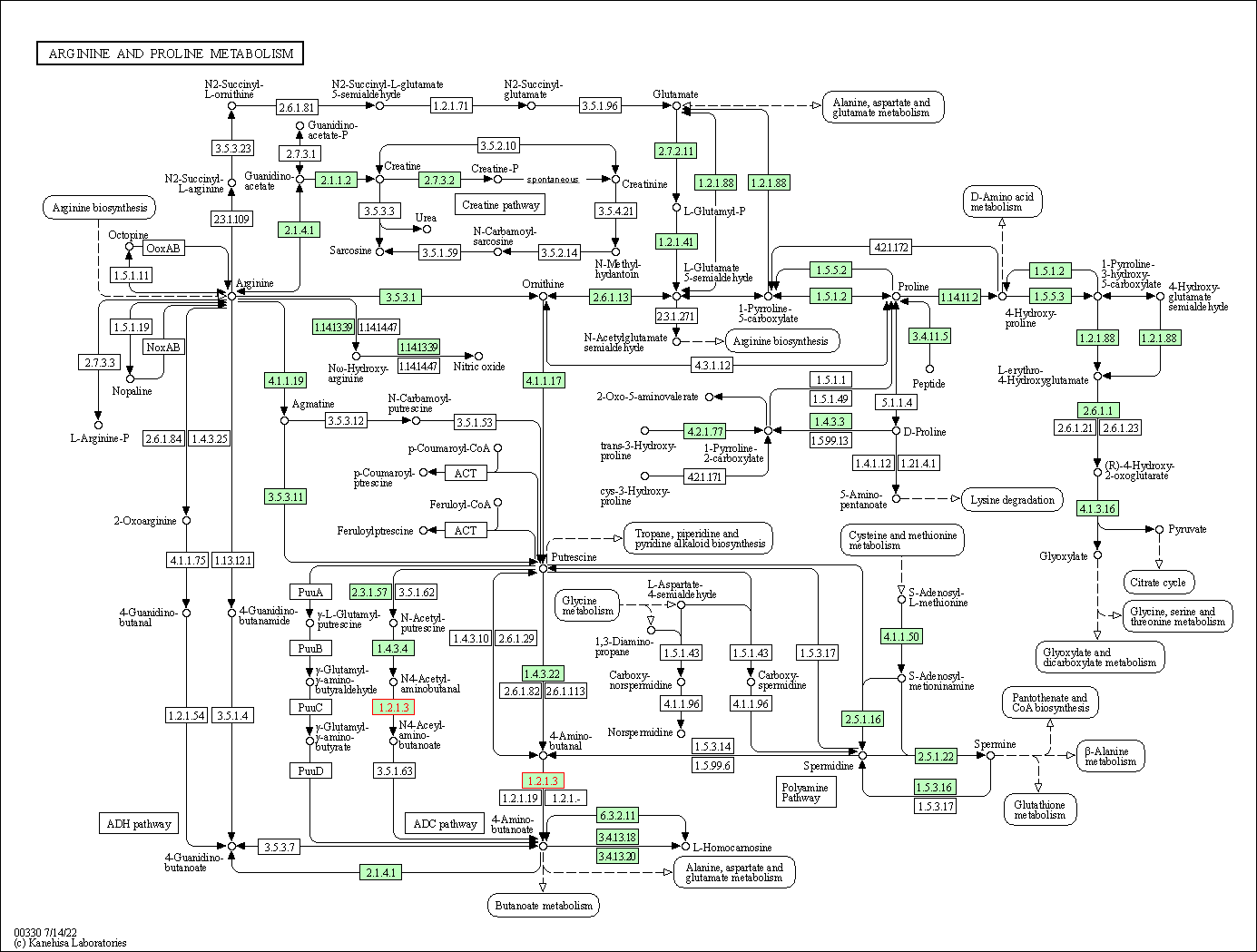
|
| Class: Metabolism => Amino acid metabolism | Pathway Hierarchy | ||
| Histidine metabolism | hsa00340 | Affiliated Target |
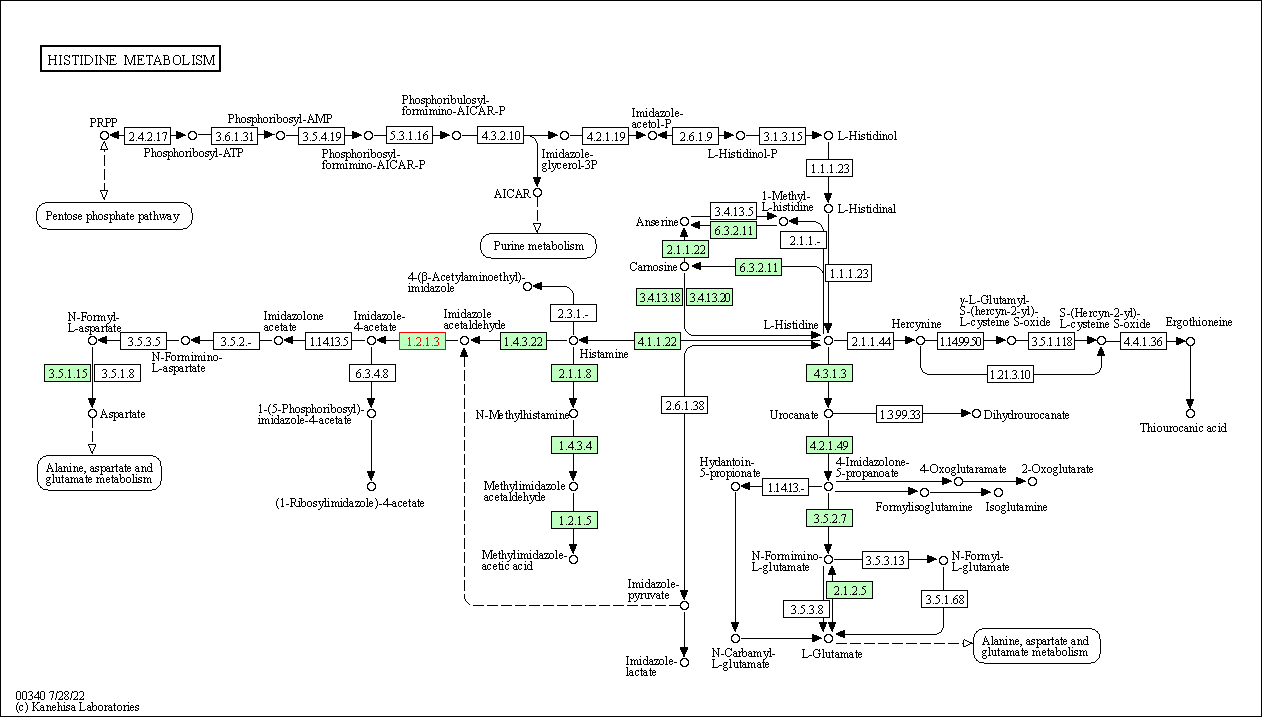
|
| Class: Metabolism => Amino acid metabolism | Pathway Hierarchy | ||
| Tryptophan metabolism | hsa00380 | Affiliated Target |

|
| Class: Metabolism => Amino acid metabolism | Pathway Hierarchy | ||
| beta-Alanine metabolism | hsa00410 | Affiliated Target |
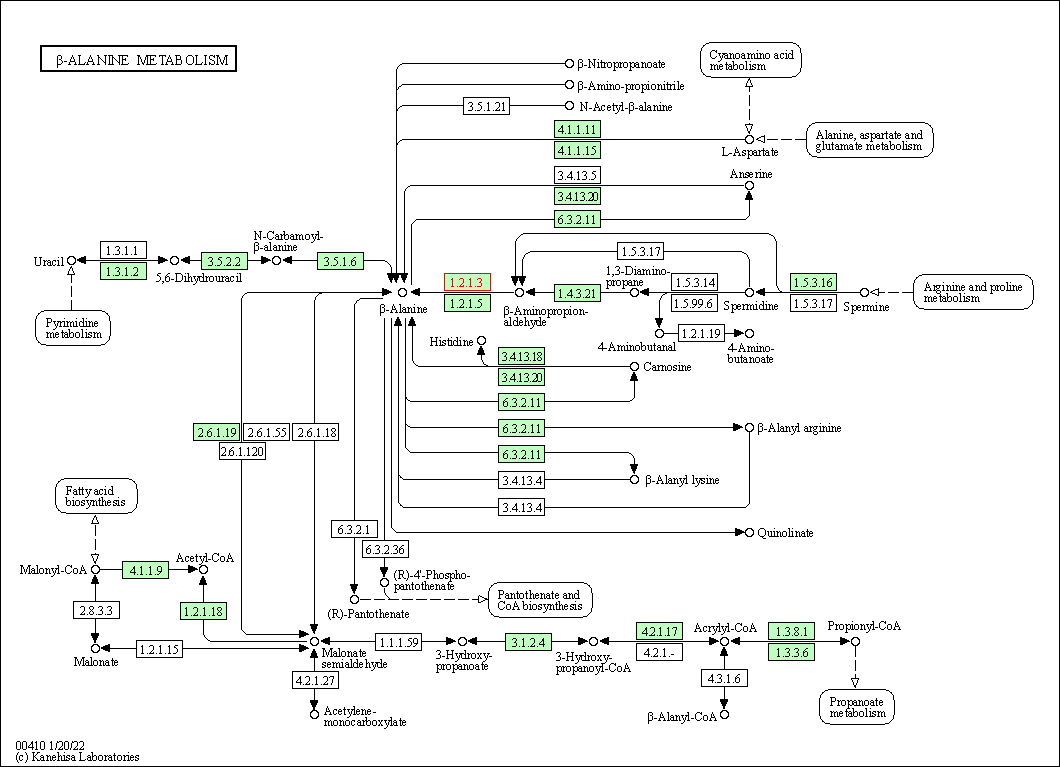
|
| Class: Metabolism => Metabolism of other amino acids | Pathway Hierarchy | ||
| Glycerolipid metabolism | hsa00561 | Affiliated Target |
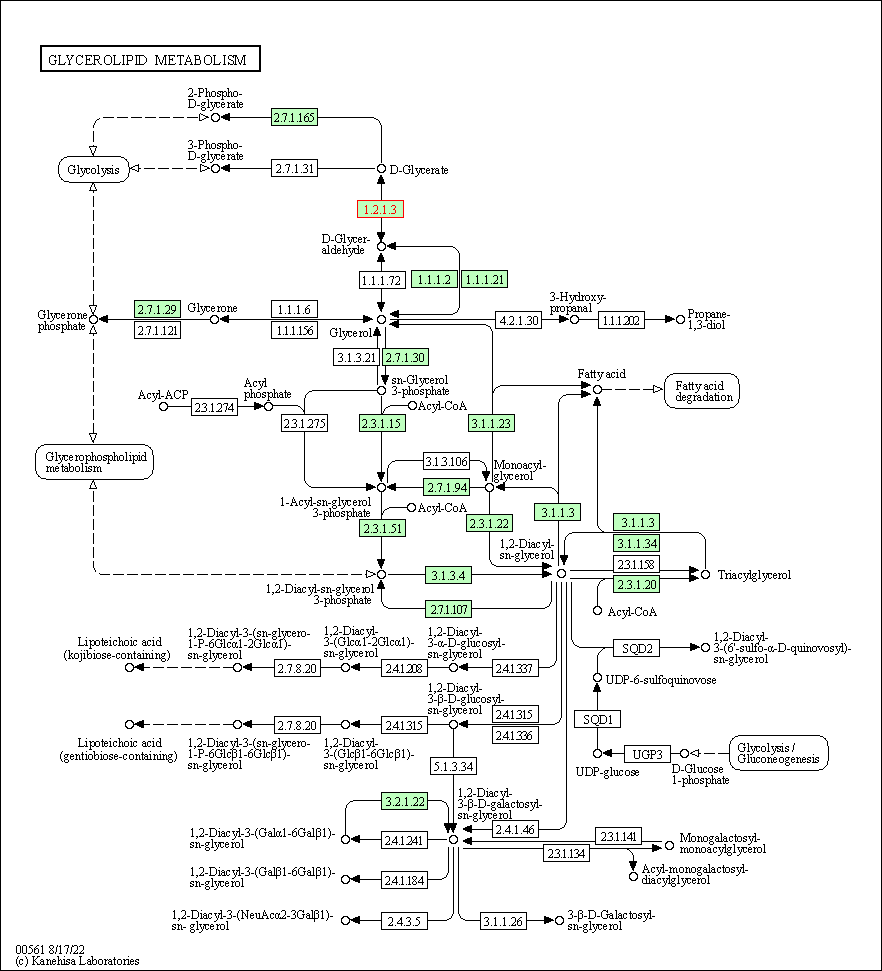
|
| Class: Metabolism => Lipid metabolism | Pathway Hierarchy | ||
| Pyruvate metabolism | hsa00620 | Affiliated Target |

|
| Class: Metabolism => Carbohydrate metabolism | Pathway Hierarchy | ||
| Pantothenate and CoA biosynthesis | hsa00770 | Affiliated Target |
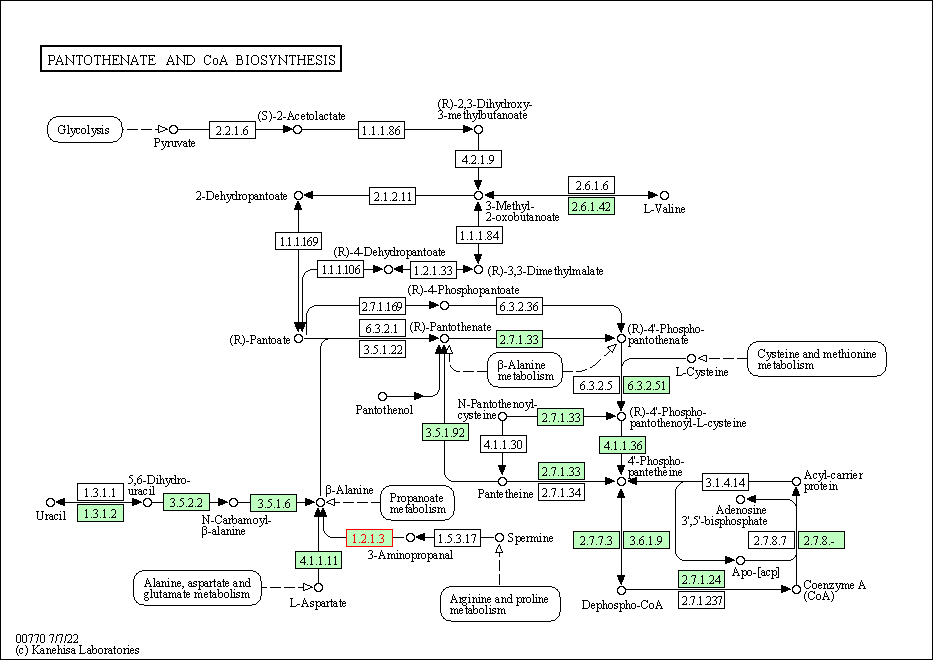
|
| Class: Metabolism => Metabolism of cofactors and vitamins | Pathway Hierarchy | ||
| Click to Show/Hide the Information of Affiliated Human Pathways | |||
| Degree | 10 | Degree centrality | 1.07E-03 | Betweenness centrality | 1.84E-03 |
|---|---|---|---|---|---|
| Closeness centrality | 1.92E-01 | Radiality | 1.33E+01 | Clustering coefficient | 1.33E-01 |
| Neighborhood connectivity | 8.60E+00 | Topological coefficient | 1.28E-01 | Eccentricity | 11 |
| Download | Click to Download the Full PPI Network of This Target | ||||
| Chemical Structure based Activity Landscape of Target | Top |
|---|---|
| Drug Property Profile of Target | Top | |
|---|---|---|
| (1) Molecular Weight (mw) based Drug Clustering | (2) Octanol/Water Partition Coefficient (xlogp) based Drug Clustering | |
|
|
||
| (3) Hydrogen Bond Donor Count (hbonddonor) based Drug Clustering | (4) Hydrogen Bond Acceptor Count (hbondacc) based Drug Clustering | |
|
|
||
| (5) Rotatable Bond Count (rotbonds) based Drug Clustering | (6) Topological Polar Surface Area (polararea) based Drug Clustering | |
|
|
||
| "RO5" indicates the cutoff set by lipinski's rule of five; "D123AB" colored in GREEN denotes the no violation of any cutoff in lipinski's rule of five; "D123AB" colored in PURPLE refers to the violation of only one cutoff in lipinski's rule of five; "D123AB" colored in BLACK represents the violation of more than one cutoffs in lipinski's rule of five | ||
| Target Poor or Non Binders | Top | |||||
|---|---|---|---|---|---|---|
| Target Poor or Non Binders | ||||||
| Target Affiliated Biological Pathways | Top | |||||
|---|---|---|---|---|---|---|
| KEGG Pathway | [+] 14 KEGG Pathways | + | ||||
| 1 | Glycolysis / Gluconeogenesis | |||||
| 2 | Pentose and glucuronate interconversions | |||||
| 3 | Ascorbate and aldarate metabolism | |||||
| 4 | Fatty acid degradation | |||||
| 5 | Valine, leucine and isoleucine degradation | |||||
| 6 | Lysine degradation | |||||
| 7 | Arginine and proline metabolism | |||||
| 8 | Histidine metabolism | |||||
| 9 | Tryptophan metabolism | |||||
| 10 | beta-Alanine metabolism | |||||
| 11 | Glycerolipid metabolism | |||||
| 12 | Pyruvate metabolism | |||||
| 13 | Metabolic pathways | |||||
| 14 | Biosynthesis of antibiotics | |||||
| Pathwhiz Pathway | [+] 8 Pathwhiz Pathways | + | ||||
| 1 | Beta-Alanine Metabolism | |||||
| 2 | Ethanol Degradation | |||||
| 3 | Histidine Metabolism | |||||
| 4 | Valine, Leucine and Isoleucine Degradation | |||||
| 5 | Pyruvate Metabolism | |||||
| 6 | Oxidation of Branched Chain Fatty Acids | |||||
| 7 | Glycine and Serine Metabolism | |||||
| 8 | Tryptophan Metabolism | |||||
| WikiPathways | [+] 4 WikiPathways | + | ||||
| 1 | Tryptophan metabolism | |||||
| 2 | Fatty Acid Omega Oxidation | |||||
| 3 | Phase 1 - Functionalization of compounds | |||||
| 4 | Neurotransmitter Clearance In The Synaptic Cleft | |||||
| Target-Related Models and Studies | Top | |||||
|---|---|---|---|---|---|---|
| Target Validation | ||||||
| References | Top | |||||
|---|---|---|---|---|---|---|
| REF 1 | A novel aldehyde dehydrogenase-3 activator leads to adult salivary stem cell enrichment in vivo. Clin Cancer Res. 2011 Dec 1;17(23):7265-72. | |||||
| REF 2 | ClinicalTrials.gov (NCT01273337) Study of ALD-401 Via Intracarotid Infusion in Ischemic Stroke Subjects. U.S. National Institutes of Health. | |||||
| REF 3 | Clinical pipeline report, company report or official report of the Pharmaceutical Research and Manufacturers of America (PhRMA) | |||||
| REF 4 | Clinical pipeline report, company report or official report of the Pharmaceutical Research and Manufacturers of America (PhRMA) | |||||
| REF 5 | Trusted, scientifically sound profiles of drug programs, clinical trials, safety reports, and company deals, written by scientists. Springer. 2015. Adis Insight (drug id 800040688) | |||||
| REF 6 | Clinical pipeline report, company report or official report of Gilead. | |||||
| REF 7 | Therapeutic target database update 2012: a resource for facilitating target-oriented drug discovery. Nucleic Acids Res. 2012 Jan;40(Database issue):D1128-36. | |||||
| REF 8 | How many drug targets are there Nat Rev Drug Discov. 2006 Dec;5(12):993-6. | |||||
| REF 9 | Structure of daidzin, a naturally occurring anti-alcohol-addiction agent, in complex with human mitochondrial aldehyde dehydrogenase. J Med Chem. 2008 Aug 14;51(15):4482-7. | |||||
| REF 10 | Coenzyme isomerization is integral to catalysis in aldehyde dehydrogenase. Biochemistry. 2003 Jun 17;42(23):7100-9. | |||||
| REF 11 | Vascular bioactivation of nitroglycerin by aldehyde dehydrogenase-2: reaction intermediates revealed by crystallography and mass spectrometry. J Biol Chem. 2012 Nov 2;287(45):38124-34. | |||||
If You Find Any Error in Data or Bug in Web Service, Please Kindly Report It to Dr. Zhou and Dr. Zhang.

